Water power. Our ancestors, those stalwart souls who headed off into the wilderness to build new settlements, depended on it. They dammed streams and rivers to power the mills that were essential to those early, self-sufficient communities. The flowing water sawed their lumber and ground their grain, and, once the land had been cleared for farming, even kept their milk and cheese cool in hot weather. Mill ponds provided fishing in summer and ice skating in winter.
By 1840, Americans had built more than 31,000 sawmills (the first water powered sawmill in the New World was built in York, Maine, in 1623), and there were as many or more grist mills besides. When driving around old communities today, you can see road names like Gristmill Lane and Mill Street, which are often the only traces left of those old mills.
One of these old mills has recently been restored to its late-1800s working order. The Robinson Mill, built in 1803 in Calais, Vermont, still uses water power to saw lumber – one of the few in the region that can. Elliott Morse, the four-times great-grandson of Joel Robinson, the builder of the mill, was the driving force behind the restoration. Morse says that Robinson made the trek from Rehoboth, Massachusetts, to Calais in 1792 to buy a tract of land that was available for payment of back taxes – only 15 shillings, or $2.50 in that era’s dollars.
Mills were the center of commerce in those days, and roads tended to converge near them. The Robinson Mill is just down the road from Kent’s Corner, which became an important crossroads – for awhile. It was a stop on the Boston-to-Montreal stagecoach route. However, with the advent of railroads, the Corner declined as a center of commerce, though many of its old houses and barns, built with lumber from the mill, still exist. The Robinson Mill retains most of its original post-and-beam timbers, showing their hand-hewn adze marks.
The earliest sawmills, including this one, used “up-and-down saws.” Powered by belts driven by water power, the saw was set up to move up and down as it sawed through a log pushed to it by other water-driven machinery. An old board, showing the vertical cut marks from an up-and-down saw, hangs on the back wall of the mill today.
Sawing occurred mostly in late winter or spring, since all sawmills could operate only when water levels were high. In mid-winter, mill ponds were frozen, and besides, saws couldn’t easily cut through frozen logs. In summer, water flow was usually too low. Without forests to hold water and release it gradually, fast runoff resulted in both spring flooding and summer drought. The Robinson Mill was known locally as “the Thunderstorm Mill” since, like most mills at that time, it took heavy rains to provide enough water for sawing out of season.
Abdiel Kent (Kent’s Corner is named for his family) bought the mill in 1876 and increased the mill’s power by replacing the original overshot water wheel with a turbine (a small horizontal water wheel with blades enclosed, originally designed by Leonardo da Vinci). He also installed a circular saw (they came into use about 1840) for more speed. The older up-and down saw cut only on the downstroke, and the story goes that a man could finish his chores before one board was cut.
In an attempt to keep the mill going in the 1940s, two truck engines were hooked up to power the saw, but even so the mill was forced to close by 1958. Then in the 1970s, Stanley Fitch (the grandson of one of the previous owners of the mill) and some neighbors formed the Aldrich Foundation to repair the deteriorating building. The foundation, a memorial to James Aldrich, who became very fond of the mill when he lived in the house across the road, raises funds for maintenance and strives to keep alive the knowledge of how sawmills used to operate.
Restoration didn’t include the machinery, and about five years ago, Morse says, he decided, “The mill has to run again.” He enlisted his uncle, Bernard Morse, a machinist, to help. Some parts were missing, but fortunately, the cross shaft linking the saw and turbine had survived and was found in a barn at Kent’s Corner after a 45-year sleep there. When loaded onto the bucket of Stanley Fitch’s tractor, the approximately 700-pound shaft kept one of the tractor’s back wheels in the air during the trip down the road.
The turbine was another story. “When we pried the rusty cast iron wheel from its tomb in the mud,” Elliott Morse says, “the runner bearing, the center part, dissolved into powder, even though it had been made from the hardest, densest wood there is – lignum vitae.” After several years rebuilding it, the Morses started the mill – and with a sinking feeling, saw all 30 of the turbine’s new wooden teeth (which mesh into an iron gear shaft) fly out and float downstream.
The Morses rebuilt the turbine again – fastening the teeth with screws this time – and Morse, Fitch, and David Newhall, president of the Aldrich Foundation and a retired machinist, now run the mill every autumn (unless the logs are frozen) during the annual community corn roast.
They’ll also saw some boards on special occasions when conditions permit, and on one day in April 2007, conditions for sawing at the Thunderstorm Mill were ideal. Water from a heavy, late-season snow and from a week of rain crashed over the dam spillway. Morse, down on his knees on a small perch by the dam, began turning the hand wheel to open the sluice gate. As water poured down through the penstock (a large diameter pipe) into the turbine, the blades began to turn, throwing thumping, pulsing, twirling showers of water out the bottom of the turbine house.
Connected to the turbine by gears and flat belts, the saw started to spin, almost silently. Newhall advised onlookers to stay out of a direct line with the saw in case the saw threw its removable teeth. And it has. Before the old roof was replaced, Morse found indentations from flying teeth on its underside.
Newhall, using a cant hook, pried a poplar log from a pile on the bank alongside the mill. He rolled it across a trestle onto the log carriage. After aligning the log, he secured it by whacking two iron dogs – heavy bars with sharp tips – into the top of the log. Then, pulling steadily and gently on the log carriage advance lever, he engaged water power to send the log easing into the saw.
With a shrill rasp, sawdust began to fly. An hour of sawing produced two neat stacks of wood – one of slabs of bark, the other of inch-thick boards. Then, since the pond was nearly drained, Newhall’s grandson closed the sluice gate and the saw spun to a stop. All ponds eventually silt in and shrink in size, and the Robinson Mill pond is no exception. But for now, Morse, Newhall, and Fitch will continue to operate the mill in short, intermittent bursts, just like a thunderstorm.


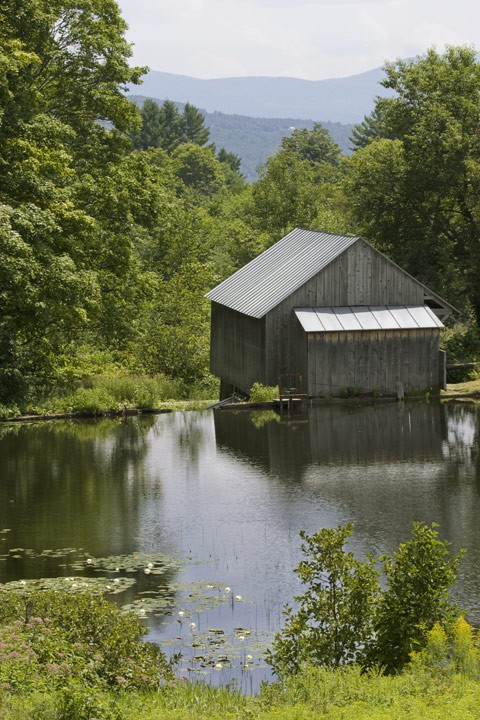
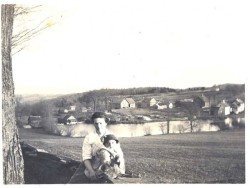

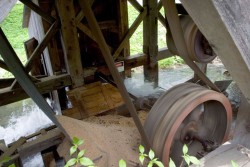
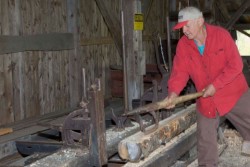

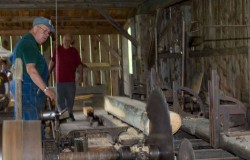
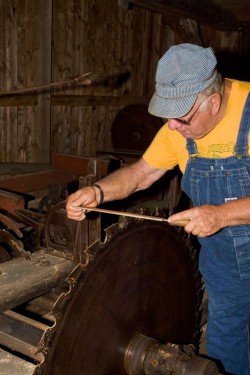


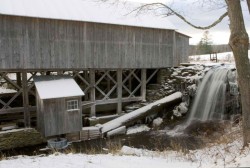
Discussion *